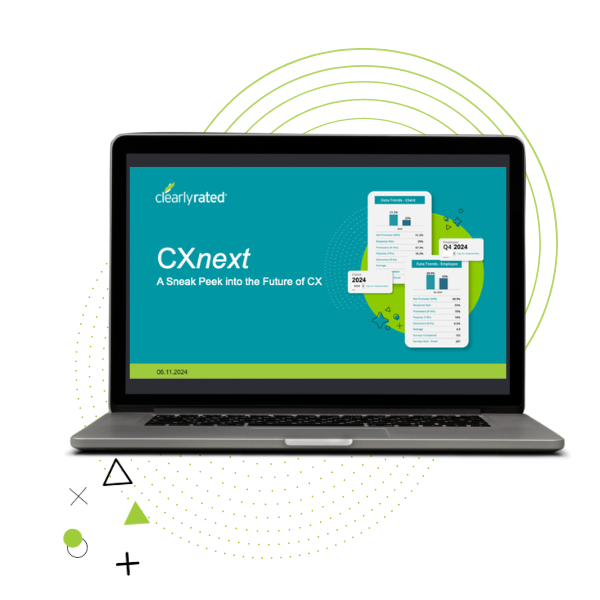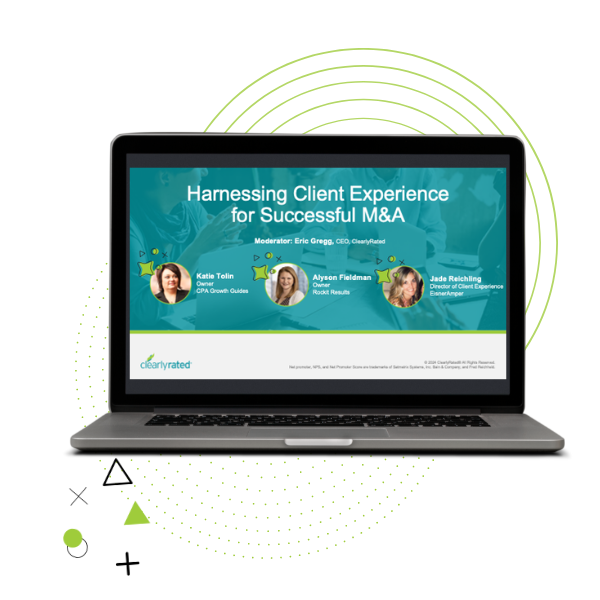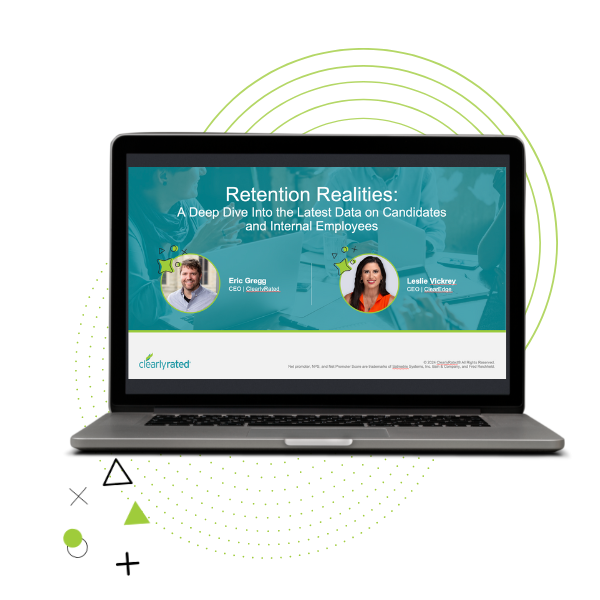A common question we hear from B2B firms that survey their clients is how to improve their client survey response rate. Put differently, they want to know how they can grow the percentage of clients who provide feedback when asked.
While this may seem like a basic question, these folks are right on track. It doesn’t really matter what your response rate is – improving that number will ALWAYS improve the return on your client survey investment.
Fortunately, the team here at ClearlyRated has fielded our fair share of surveys (more than 1 million in the last ten years) and we’ve found 4 best practices that, when applied strategically and systematically, can help any business –especially professional and B2B service firms – facilitate powerful response rates on client surveys.
1. Master the science of survey design.
When it comes to maximizing response rates, “survey design” is as much a science as it is an art. Beyond using nice looking fonts and colors, there are 3 tactical elements to survey design that can make the survey-taker’s experience feel easy and efficient. The below recommendations aren’t about look-and-feel, they are about leveraging discipline and attention to detail to improve response rate.
- Personalize the Survey Invitation – One of our top recommendations is to personalize your survey outreach wherever possible, and the emails that you send inviting clients to take the survey are just the place to start. Your clients are more likely to open an email from a person they know, like their primary point of contact, much more so than a generic email “from” the company. That applies to the styling of the email as well! We’ve found that ditching HTML in favor of plain text survey invitations elicits higher response rates – likely because the client perceives the email to be coming from a person they know.
- Keep the Questionnaire Succinct – Here’s where discipline comes in to play… it can be tempting to add question after question to a client survey, but this approach can also be massively detrimental for your response rate. We find that surveys longer than 10 questions have lower average response rates than their shorter counterparts. And easy-to-answer (mostly multiple choice) questions can mean the difference between a survey that’s abandoned versus completed!
Sample Net Promoter Score® survey question:

- Create an Intuitive, Accessible Survey Experience – It’s 2019, which means that your clients are accessing digital experiences from devices of all shapes and sizes. Client surveys are no different! Ensuring that your survey is optimized for mobile viewing can mean the difference between a client taking the 2 minutes to respond on the run versus archiving the invitation and forgetting it entirely. We have also found that the ability to see or “preview” the entirety of the survey creates a higher likelihood of survey completion. If the client is able to see all questions at once, they can assess the amount of time they will need to invest to complete. Assuming you took our advice on keeping your survey succinct, allowing the respondent to “preview” should work in your favor by encouraging a quick completion.
2. Communicate – before, during, and after your survey.
Consistent communication, while simple in theory, is the most-often missed component of client survey initiatives. If your team is able to think about and execute a communication plan that “wraps around” your survey initiative (like a bow tie, or a bear hug) your response rates are bound to improve. We always recommend that businesses think about the following key touch points to communicate about (and encourage feedback via) a client survey:
- Before the survey invites go out.
Have account managers or relationship leads give their clients a heads up that they should expect to see a survey invitation hit their inboxes in the coming day or week. Bonus points if you provide context about the purpose of the survey and make it clear how much that particular client’s feedback means to you (personalization, anyone?!). - While the survey is in the field.
Monitor and follow up with clients who haven’t yet completed the survey. Reach out again to communicate how valuable their input is to your business. Best-case scenario? You earn more survey completes and a higher response rate. Worst-case scenario? You earn bonus points for proactively letting clients know how much their experience means to you. There are no losers here! - After the survey closes.
If you have time, it can be very powerful to follow up individually with clients who have taken time to provide you with feedback via the survey. Not only will they feel the figurative “love” – but it offers you an opportunity to be personal (there it is again!) with your messaging, responding to concerns or recognition individually to build the relationship and foster goodwill for future surveys.
Even if you’re not able to follow up with everyone who completed a survey individually, you absolutely MUST follow up with your entire client base to share what you’ve learned from the survey. Why would clients feel compelled to respond to surveys in the future if they aren’t able to see how their feedback is impacting your business?
Our favorite way to accomplish this is through the “2-1-1 follow up methodology,” generally executed as an email follow up to your entire client base at the close of a survey.
In that email you will:
- Share 2 things you learned you’re doing really well.
Start by taking the opportunity to “toot your own horn” – share 2 things you learned you’re doing really well. Do a majority of your clients think you’re very responsive? Share it with pride! Satisfaction surveys aren’t (and shouldn’t be) meant to just identify what you’re doing wrong, but also recognize and reinforce areas where your organization and team excel. - Share 1 area you learned needs improvement.
Next, share 1 area of your service delivery you learned you can improve on. While you will likely receive feedback that identifies opportunities for improvement in various aspects of your service offering, the key is to zero in on your most common service issue that can realistically be improved. - Share 1 action you’re taking to improve.
Wrap it all up by sharing a brief description of 1 plan of action you’ve implemented to establish change that relates to resolving the service issue identified. Something measurable is best so that your clients can actually read and recognize the improvement as it’s happening and equate it to the feedback they’ve provided.
Failing to continue the conversation after a survey closes invites disappointment from your clients who did take time to provide you with feedback, and may have a negative impact on response rates in the future. Follow up, follow up, follow up!
3. Ensure clients receive your survey invitations.
 You’ll undoubtedly agree, whether or not your survey invitation emails actually land in your clients’ inboxes has a massive impact on the number of responses you will receive. And while email deliverability is a hot topic for marketers in the modern era, it’s an easily overlooked aspect of maximizing survey response rates.
You’ll undoubtedly agree, whether or not your survey invitation emails actually land in your clients’ inboxes has a massive impact on the number of responses you will receive. And while email deliverability is a hot topic for marketers in the modern era, it’s an easily overlooked aspect of maximizing survey response rates.
Of the many factors that can affect email deliverability, server reputation plays a critical role. Emails consisting of large contact lists are often sent through an automated process through a third-party vendor… For this reason, it is crucial to check your service provider’s IP address before you begin sending emails. Good or bad, these servers most likely already have a reputation themselves – and the success of your deliverability relies on a strong server reputation.
You’ll also want to pay attention to how you can minimize email unsubscribes and bounces. Start by taking CAN-SPAM seriously. One of the frequent reasons emails are not delivered has to do with a low sender score. Internet Service Providers reject any emails that fall below a certain score threshold (your Sender Score is tied to the IP address of your outgoing mail server). Email bounces can be avoided by keeping your contact lists pristine (just keep scrubbing!).
4. Make it personal.
You’ve heard it at least 5 times in this blog post. Creating a personalized experience for your clients is the most powerful way to boost response rates.
Your clients have no relationship with your marketing department – their relationship is (and should be) with an individual. People asking for feedback will always beat a faceless brand because service is personal! And if you can’t make your survey look like it’s coming from one individual to another, it will be difficult to persuade someone to take the time out of their day to give you feedback. One way to personalize your brand is to switch up the conversational tone by adding in pronouns like “we” and “I” – your customers will respond positively to the more informal tone and you will walk away with actionable feedback!
Interested in learning how ClearlyRated can help you launch a client survey that maximizes response rates and ROI? Simply fill out this form or call us at 1.800.921.2640 to discuss best practices and get a tour of our survey platform.





